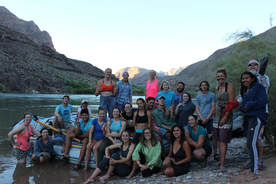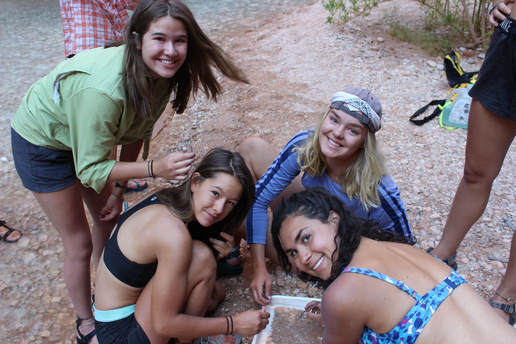
In the bottom of the Grand Canyon in the sweltering June dusk, 14 mustached (permanent marker enhanced) youths gathered around to witness a timid squirrel named “Pink Paws” marry “Cut Throat” the killer mermaid. The rather ridiculous vision of a squirrel hand puppet being wed to a mermaid dog chew toy will live on only in the memories of the youths, raft guides, and scientists witness to the riverside ceremony. All the cameras had run out of batteries days before. Musical accompaniment was the ruckus laughter of the young people who were thoroughly enjoying themselves in this wild place.
This is a Grand Canyon Youth trip (GCY). Youths aged 15-19 sign up on a first-come basis to raft half of the Grand Canyon (either starting at Lee’s Ferry or the Bright Angel Trail) for 9 days. The mission: do science and have the time of your life! By incorporating scientific research into these trips, GCY is able to partner with the US Geological Survey’s Grand Canyon Monitoring and Research Center for river permits and equipment. I was lucky enough to be one of the scientists invited on not one, but TWO of these trips!
My research examines the movements of aquatic insects between Grand Canyon tributaries (small streams following into larger rivers, in this case the Colorado River). On these trips, I give the youth nets and show them how to collect aquatic insects. We use tweezers to pick particular insects out of the nets, while sitting in the shade of soaring rock walls. The youths learn to recognize mayflies, water striders, and caddisflies, the insects that I use in my research. I explain that I take the insects back to the lab, extract the DNA, and use the DNA sequences to tell me how related different populations are among tributaries throughout the Grand Canyon. This knowledge will help us better understand their movements between habitats, which will aid in their conservation. The youths are engaged, showing genuine interest and enthusiasm (yelling, "YAY SCIENCE," is common) in the scientific projects for which they are helping to collect the data.
When not helping with the science, the youths are being LOUD and SILLY, exploring and building new friendships. Many are in transition, from middle to high school or high school to college and from youth to adult. The scientists and raft guides treat these high school students largely as adults, capable of doing science, preparing meals, and making their own decisions about when and where to explore. These trips are truly transformative experiences for the youths. I know because they tell us in their own words. I also find them transformative for myself. Graduate school can seem like quite the slog, but these trips rejuvenate me, by reminding me that being loud and silly is healthy and that my science is indeed interesting and important. I am truly grateful that Grand Canyon Youth exists that I am a part of this wonderful organization.
If you are or know a high school student, look into Grand Canyon Youth (video to get you stoked)!
This is a Grand Canyon Youth trip (GCY). Youths aged 15-19 sign up on a first-come basis to raft half of the Grand Canyon (either starting at Lee’s Ferry or the Bright Angel Trail) for 9 days. The mission: do science and have the time of your life! By incorporating scientific research into these trips, GCY is able to partner with the US Geological Survey’s Grand Canyon Monitoring and Research Center for river permits and equipment. I was lucky enough to be one of the scientists invited on not one, but TWO of these trips!
My research examines the movements of aquatic insects between Grand Canyon tributaries (small streams following into larger rivers, in this case the Colorado River). On these trips, I give the youth nets and show them how to collect aquatic insects. We use tweezers to pick particular insects out of the nets, while sitting in the shade of soaring rock walls. The youths learn to recognize mayflies, water striders, and caddisflies, the insects that I use in my research. I explain that I take the insects back to the lab, extract the DNA, and use the DNA sequences to tell me how related different populations are among tributaries throughout the Grand Canyon. This knowledge will help us better understand their movements between habitats, which will aid in their conservation. The youths are engaged, showing genuine interest and enthusiasm (yelling, "YAY SCIENCE," is common) in the scientific projects for which they are helping to collect the data.
When not helping with the science, the youths are being LOUD and SILLY, exploring and building new friendships. Many are in transition, from middle to high school or high school to college and from youth to adult. The scientists and raft guides treat these high school students largely as adults, capable of doing science, preparing meals, and making their own decisions about when and where to explore. These trips are truly transformative experiences for the youths. I know because they tell us in their own words. I also find them transformative for myself. Graduate school can seem like quite the slog, but these trips rejuvenate me, by reminding me that being loud and silly is healthy and that my science is indeed interesting and important. I am truly grateful that Grand Canyon Youth exists that I am a part of this wonderful organization.
If you are or know a high school student, look into Grand Canyon Youth (video to get you stoked)!

 RSS Feed
RSS Feed
